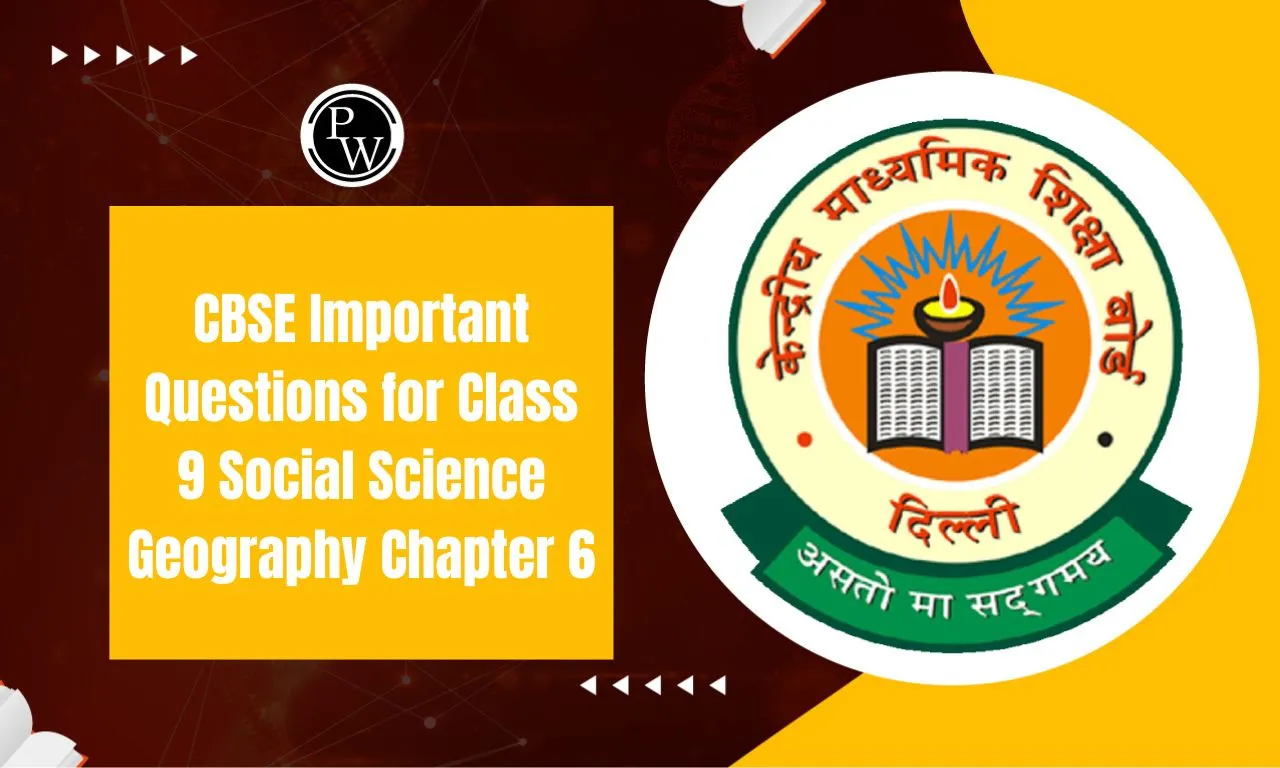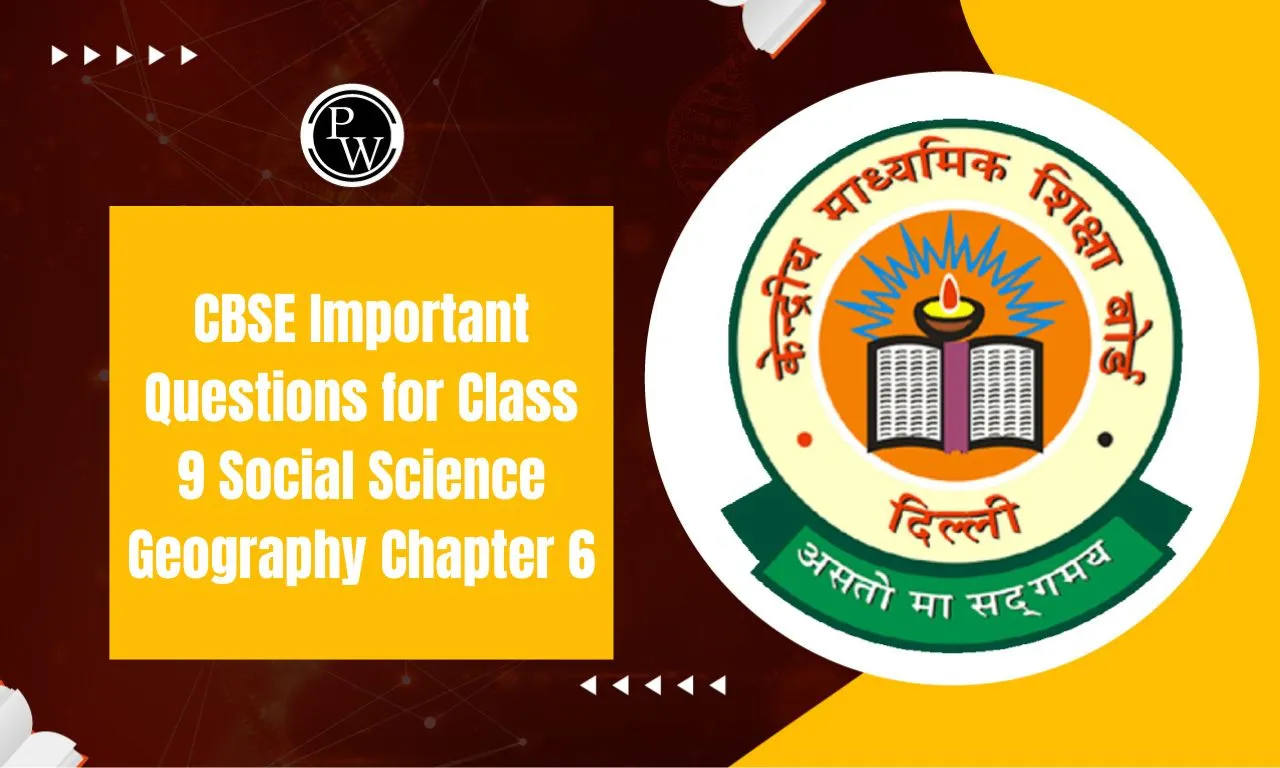

CBSE Important Questions for Class 9 Social Science Geography Chapter 6: Chapter 6 of Class 9 CBSE Social Science Geography, "Population," explores India's population dynamics. It covers population size and distribution, growth trends, and factors affecting population change like birth rate, death rate, and migration.
The chapter also discusses age composition, sex ratio, literacy rate, occupational structure, and population density. It highlights government initiatives for population control and resource management. Understanding population trends helps in planning economic development and infrastructure. The chapter emphasizes the importance of sustainable population growth and its impact on the environment and resources, making it a crucial topic for students preparing for exams.
CBSE Important Questions for Class 9 Social Science Geography Chapter 6 Overview
Chapter 6 of Class 9 CBSE Social Science Geography, "Population," covers key aspects like population size, distribution, growth, and composition. Understanding these concepts helps students analyze how population trends impact resources, economy, and development. It also covers birth and death rates, migration, literacy rates, and occupational structures, aiding in better policy-making awareness.
Studying important questions from this chapter enhances critical thinking, improves exam preparation, and boosts analytical skills. These questions help students grasp real-world population challenges, equipping them with knowledge for competitive exams and future studies in economics, sociology, and geography, making learning more practical and relevant.
CBSE Important Questions for Class 9 Social Science Geography Chapter 6 PDF
Chapter 6 of Class 9 CBSE Social Science Geography, "Population," explains population distribution, growth, and composition in India. It covers birth and death rates, migration, literacy levels, and occupational structures. Understanding these topics helps students analyze how population affects resources and development. Studying important questions from this chapter enhances exam preparation, critical thinking, and awareness of real-world demographic challenges, making learning more practical and relevant.
CBSE Important Questions for Class 9 Social Science PDF
CBSE Important Questions for Class 9 Social Science Geography Chapter 6 with Answers
Below is the CBSE Important Questions for Class 9 Social Science Geography Chapter 6 Population -
1. Which of the following is not a major factor influencing the distribution of population?
(A) Climate (B) Landforms
(C) Polity (D) social factors
Ans. (C) Polity
2. Which of the following terms is used to refer to the average number of persons per square
kilometer?
(A) Literacy rate (B) Population density
(C) Birth rate (D) Death rate
Ans. (B) Population density
3. Which of the following regions has the highest population density in the world?
(A) North America (B) Asia
(C) Africa (D) South America
Ans. (B) Asia
4. Which of the following factors is not responsible for the uneven distribution of population in India?
(A) Physical features
(B) Climate
(C) Cultural factors
(D) Government policies
Ans. (D) Government policies
5. What is the main reason for the high population density along the river valleys and plains in India?
(A) Availability of water resources
(B) Fertile soil for agriculture
(C) better transportation facilities
(D) Urbanization
Ans. (B) Fertile soil for agriculture
6. Which state in India has the highest population density according to the 2011 census?
(A) Uttar Pradesh
(B) Bihar
(C) Maharashtra
(D) Kerala
Ans. (B) Bihar
7. Which of the following countries has the highest population growth rate?
(A) China (B) United States
(C) India (D) Russia
Ans. (C) India
8. Which of the following is an example of a densely populated rural region in India?
(A) Thar Desert
(B) Western Ghats
(C) Gangetic Plains
(D) Eastern Himalayas
Ans. (C) Gangetic Plains
9. What is the term used to describe the movement of people from rural to urban areas?
(A) Emigration (B) Immigration
(C) Urbanization (D) Migration
Ans. (D) Migration
10. Which of the following states in India has the highest sex ratio as per the 2011 census?
(A) Kerala
(B) Bihar
(C) Uttar Pradesh
(D) Rajasthan
Ans. (A) Kerala
11. “Assam and most of the Peninsular states have moderate population densities.” Give three reasons.
Sol. The region has hilly, dissected and rocky terrain.
The region receives moderate to low rainfall.
The region has shallow and less fertile soil.
12. Mention the process of change of population.
Sol. Birthrate Death rate Migration
13. What are the major factors responsible for internal migration?
Sol. In India, most migrations have been from the rural to the urban areas because of the “push” factor in rural areas. These are adverse conditions of poverty and unemployment in the rural areas and the “pull” of the city in terms of increased employment opportunities are better living
conditions.
14. What is sex ratio? Give two reasons responsible for an unfavorable sex ratio in India.
Sol. The number of females per thousand of males is called the sex ratio. In 1901, the ratio was 1000: 972 but it dropped to 1.000:940 in 2011. Main causes of the change of
ratio are:
-
Low social, economic and political status of women.
-
Dowry system is also responsible for this.
-
Parents also feel insecure if a girl child is born.
15. What are the significant features of the National Population Policy 2000?
Sol. National Population Policy is a policy adopted by the Government of India in 2000.
It aims at stabilizing the population by 2045.
It also lays emphasis on the economic growth, social development and environment protection.
16. “The people are important to develop the economy and society.” Explain.
Or
What is the importance of studying population?
Sol. The people make and use resources and are themselves resources with varying quality. It is the point of reference from which all other elements are observed and from which they derive significance and meaning. “Resources’, ‘calamities and ‘disasters’ are all meaningful only in relation to human beings. Their numbers, distribution, growth and characteristics or qualities provide the basic background for understanding and appreciating all aspects of the environment. Human beings are producers and consumers of earth’s resources.
Therefore, it is important to know how many people are there in a country, where do they five, how and why their numbers are increasing and what are their characteristics.
17. What is occupational structure? Explain.
Sol. Occupational structure refers to the distribution of work force among different occupations. Different occupations can be classified into three groups:
(i) Primary occupations
(ii) Secondary occupations
(iii) Tertiary occupations
(i) Primary Producers or Occupations: Those who grow natural products like crops, etc. and are mainly engaged in agriculture and allied activities.
(ii) Secondary Occupations: Those who are producing products with the help of machines like textiles, construction, etc.
(iii) Tertiary Occupations: Those who provide services like education, health services, banking, insurance, etc. About 64 per cent population of India is still engaged in the primary sector.
18. What is the relationship between age composition and dependency ratio? Explain.
Sol. The age composition of a population refers to the number of people in different age groups in a country. It is one of the most basic characteristics of a population. The age composition of
the population is expressed in three broad categories. Children below the working age (below 15 yrs.): They are economically unproductive and need to be provided with food, clothing, education, and medical care. Persons in the working age (15 to 59 yrs.):
They are economically productive and biologically reproductive. They comprise the work population. Old persons above the working age (above 59 yrs.): They can be economically productive, but need care. Anyone, who is engaged in work and can do so is part of the working population. The dependent population is either in the age group of below 15 years or in the age group of over 59 years
Benefits of Using CBSE Important Questions for Class 9 Social Science Geography Chapter 6
- Better Exam Preparation – Important questions focus on key topics, helping students prepare effectively for exams.
- Concept Clarity – Helps in understanding population distribution, growth, and factors influencing it.
- Time Management – Practicing these questions improves speed and accuracy in answering.
- Boosts Confidence – Familiarity with important questions reduces exam stress.
- Enhances Analytical Skills – Encourages students to analyze real-world demographic issues.
- Improves Retention – Repeated practice helps in better memory recall.
- Supports Competitive Exam Readiness – Builds a foundation for higher studies and entrance exams.
CBSE Important Questions for Class 9 Social Science Geography Chapter 6 FAQ
What is the importance of studying population class 9 geography?
Which is the most important chapter in geography class 9 CBSE?
What are the three 3 factors of population growth?




